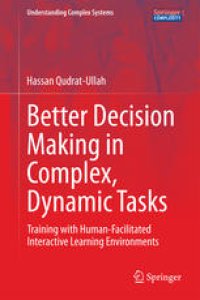
Ebook: Better Decision Making in Complex, Dynamic Tasks: Training with Human-Facilitated Interactive Learning Environments
Author: Hassan Qudrat-Ullah (auth.)
- Tags: Complex Networks, Operation Research/Decision Theory, Educational Technology, User Interfaces and Human Computer Interaction
- Series: Understanding Complex Systems
- Year: 2015
- Publisher: Springer International Publishing
- Edition: 1
- Language: English
- pdf
Computer simulation-based education and training is a multi-billion dollar industry. With the increased complexity of organizational decision making, projected demand for computer simulation-based decisional aids is on the rise. The objective of this book is to enhance systematically our understanding of and gain insights into the general process by which human facilitated ILEs are effectively designed and used in improving users’ decision making in dynamic tasks. This book is divided into four major parts. Part I serves as an introduction to the subject of “decision making in dynamic tasks”, its importance and its complexity. Part II provides background material, drawing upon the relevant literature, for the development of an integrated process model on the effectiveness of human facilitated ILEs in improving decision making in dynamic tasks. Part III focuses on the design, development and application of Fish Bank ILE, in laboratory experiments, to gather empirical evidence for the validity of the process model. Finally, part IV presents a comprehensive analysis of the gathered data to provide a powerful basis for understating important phenomena of training with human facilitated simulation-based learning environments, thereby, help to drive critical lessons to be learned. This book provides the reader with both a comprehensive understanding of the phenomena encountered in decision making with human facilitated ILEs and a unique way of studying the effects of these phenomena on people’s ability to make better decision in complex, dynamic tasks. This book is intended to be of use to managers and practitioners, researchers and students of dynamic decision making. The background material of Part II provides a solid base to understand and organize the existing experimental research literature and approaches.
This book describes interactive learning environments (ILEs) and their underlying concepts. It explains how ILEs can be used to improve the decision-making process and how these improvements can be empirically verified. The objective of this book is to enhance our understanding of and to gain insights into the process by which human facilitated ILEs are effectively designed and used in improving users’ decision making in complex, dynamic tasks. This book is divided into four major parts. Part I serves as an introduction to the importance and complexity of decision making in dynamic tasks. Part II provides background material, drawing upon relevant literature, for the development of an integrated process model on the effectiveness of human facilitated ILEs in improving decision making in dynamic tasks. Part III focuses on the design, development, and application of FishBankILE in laboratory experiments to gather empirical evidence for the validity of the process model. Finally, part IV presents a comprehensive analysis of the gathered data to illustrate the lessons to be learned.
Better Decision Making in Complex, Dynamic Tasks will be useful for managers and practitioners, researchers, and students of dynamic decision making.
Praise for Better Decision Making in Complex, Dynamic Tasks:
"...rich in content, full with unique insights, and a self-sufficient volume on the design, development and application of system dynamics based simulations that are implemented as interactive learning environments (ILEs). Practitioners and researchers interested in seeking evidence for the efficacy of ILEs’ use in decision-making will find this book a must read."
Prof. Carmine Bianchi, Scientific Coordinator of CED4-System Dynamics Group, University of Palermo, Italy